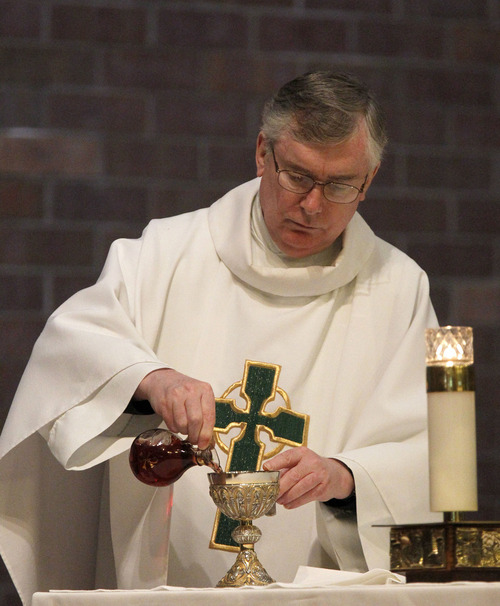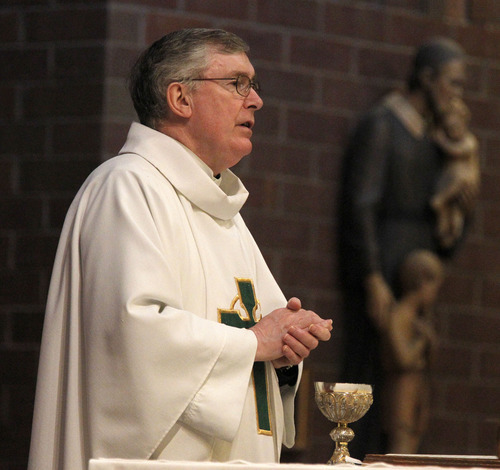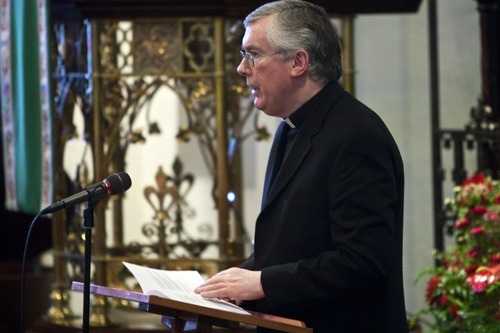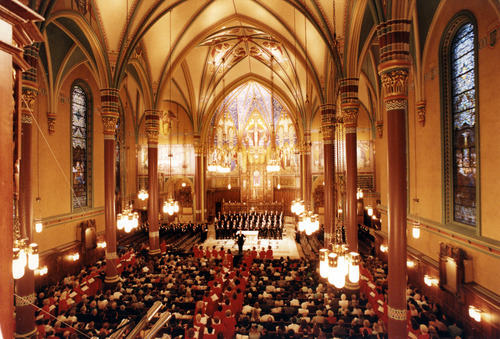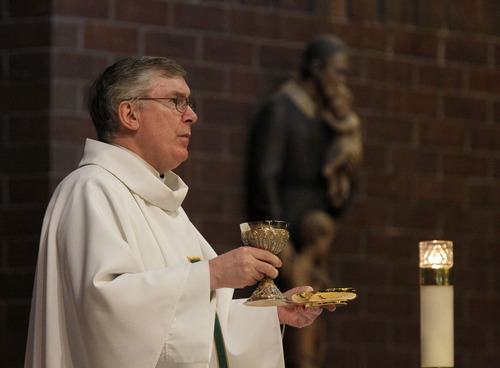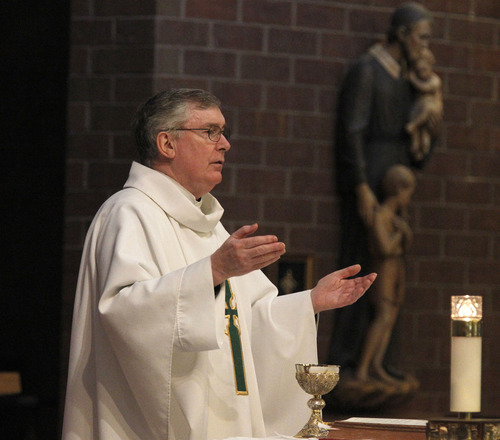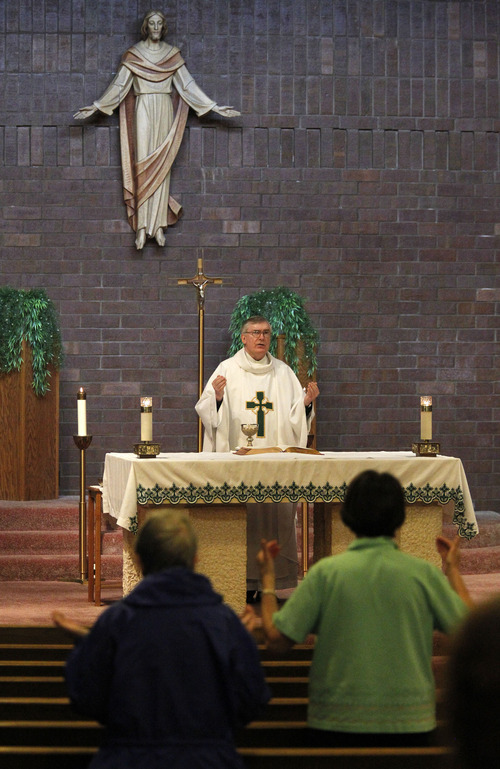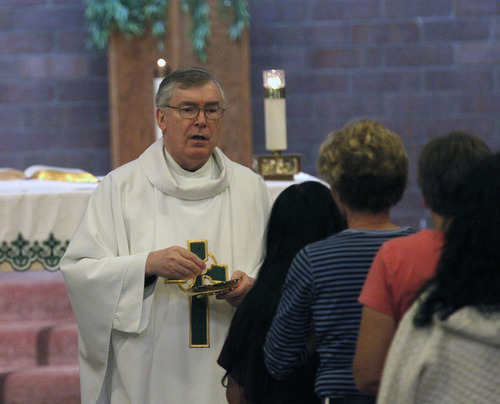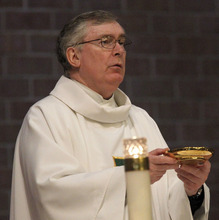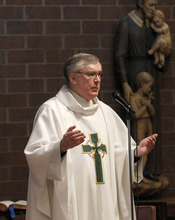This is an archived article that was published on sltrib.com in 2012, and information in the article may be outdated. It is provided only for personal research purposes and may not be reprinted.
It was Christmas Eve 2011 and the normally reserved and theologically sophisticated Monsignor Francis Mannion was wearing a red-and-green headband of battery-powered reindeer antlers with blinking lights.
The attention-grabbing tactic was meant to startle parishioners at St. Vincent de Paul Catholic Church in Holladay into giving thousands of dollars to a fund for the poor.
It worked.
Though extraordinary, the stunt fit Mannion's often-dry sense of humor, members say, and his passion for those in need.
"He's quite serious and private, so to do this was in many ways out of character," said Christine Sharer, who was there that night. "But he has great feelings for the poor and the marginalized in society and has stretched everyone's ability to be inclusive and charitable in that regard."
Now Mannion, who has been a priest in the Catholic Diocese of Salt Lake City for 39 years, is stepping down as pastor and going into semi-retirement.
As an emeritus pastor, the 63-year-old cleric will continue officiating at Mass, baptisms, confirmations, weddings and funerals as well as providing some adult education but will relinquish all his administrative assignments with the parish.
This is due largely to medical issues that have arisen in the past year, Mannion said in an interview this week.
"I've been diagnosed with a neuropsychological condition that prevents me from fulfilling all my duties," the monsignor said. "My brain doesn't function in the way it needs to function."
On top of that, Mannion suffered a minor stroke in March, leaving him nearly blind in his left eye.
"I was really despondent about it for a while," he said. "But now I've adjusted to it and my good eye compensates."
And, he insists, this is hardly the end of his priestly contributions.
"I'm not dead yet," Mannion jokes, alluding to a famous movie line from "Monty Python and the Holy Grail."
It is, however, an unexpected turn in a decades-long religious career.
—
A priest pipeline • Mannion grew up in rural Ireland in a devout Catholic family, the kind in which at least one son typically was expected to be a priest.
Young Francis knew early that he would be the one.
"It probably came from my grandmother," Mannion recalled. "She talked about it a lot."
The boy from Galway entered an Irish seminary at age 19 in 1967 and was ordained six years later in the soaring cathedral of Thurles, surrounded by family and friends.
In 1973, Mannion found himself across the Atlantic in a mountain desert known as Utah.
Starting with the state's first Catholic bishop, Lawrence Scanlan, who arrived in the late 19th century, Mannion said, there has been a "long list" of Irish priests serving in the headquarters of the LDS Church.
"Utah fell into my lap or I fell into its," he said, "and here I am."
The new priest served in two parishes — at Our Lady of Lourdes in Magna and then St. Joseph in Ogden – before leaving for Washington, D.C., to pursue a doctorate from Catholic University in liturgy and sacramental theology.
Not long after Mannion's return to Utah in 1984, he became rector of Salt Lake City's stately Cathedral of the Madeleine, where he served as a sort of in-house theologian. He also began answering theological questions for Catholics across the nation with a weekly column in the church's official publication, Our Sunday Visitor.
But the South Temple cathedral took the bulk of his time, especially the extensive renovations begun in the early 1990s.
"The biggest challenge was to raise $10 million to make the project come to fruition," he said. "We drew on prominent members of the larger Catholic community to help with the funding."
He also was intimately involved in the landmark sanctuary's artistic renewal.
"We didn't change the art at all, just cleaned and revealed its original power. It already had a strong Spanish Gothic influence," Mannion said. "We just made the colors more vivid."
He modestly acknowledges that he proposed the installation of a shrine to Our Lady of Guadalupe, a patron saint of Latinos, which has proven to be an important symbol of the Utah diocese's growing Spanish-speaking Catholic population.
Bringing the cathedral back to its pristine condition, including moving Scanlan's remains into a more prominent location, Mannion said in 1993, reminded worshippers "of our roots as a Catholic community in Utah and our debt to those who have gone before us.''
It also was his idea to launch the Madeleine Choir School, which has won national and international acclaim.
But his main love has always been the teachings and rites of the faith.
—
Liturgy and empathy • After two terms as rector, Mannion left the state in 2000 for Chicago, where he founded the Mundelein Liturgical Institute. After two years, he returned to become the pastor at St. Vincent, where he has served ever since.
"He is a master liturgist," said Mark Longe, principal of St. Vincent de Paul Catholic School. "He makes sure it is done the way it is supposed to. He believes beautiful teachings and rites are there for a reason, and he upholds them in a real and beautiful way."
Sharer, of Murray, echoes that appraisal.
"He's a well-known theologian who is known beyond the boundaries of the parish and diocese and has published in national publications."
Those at St. Vincent have had "the advantage of having a sacramental theologian as our parish priest," she said. "The depth of his homilies and his teachings within the parish are something we've all benefited from over the years."
Mannion also has spoken eloquently of the pain he's felt during the explosive priest abuse crisis, which has consumed the American church and the public in the past decade.
In 2010, the Irish-born pastor was stunned by new reports of similarly horrific cases in Ireland, Germany and a deaf school in Milwaukee.
During the Easter season, Mannion described his "dismay" that the term "priest" had become so shameful, Sharer said. "He talked about his own sister in Ireland having been abused by a local priest and the need to honor the experience of people like her."
At that time, Sharer said, his remarks "mirrored the pope's call for the need for repentance."
Such empathy, Longe said, is part of Mannion's nature.
"He's good with people who share problems," the principal said. "He's especially great one on one. Everyone says so."
And that will continue, he said. "We are lucky that we will still have his presence."


